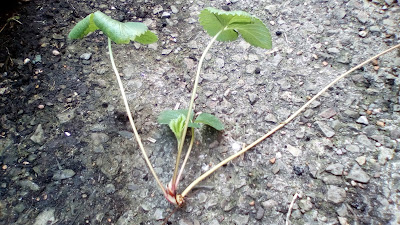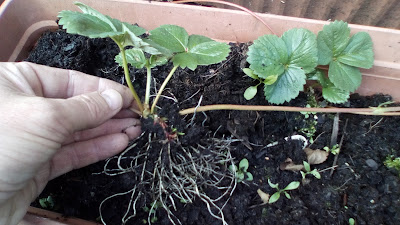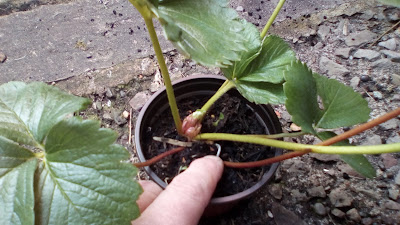Getting new plants from runners costs nothing, and nature does most of the work for you - it's really simple!
This is the fourth and final post in my series of Beginner's Guides to propagating new plants. If you thought it was easy to sow seeds, take cuttings or plant bulbs, then you won't believe how easy it is to get new plants from runners. In fact they might already be out there in your garden waiting for you. All you have to do is pot them up!
How to sow seeds - A Beginner's Guide
How to take cuttings - A Beginner's Guide
How to plant bulbs - A Beginner's Guide
How to sow seeds - A Beginner's Guide
How to take cuttings - A Beginner's Guide
How to plant bulbs - A Beginner's Guide
What are runners?
Different plants find different ways of spreading themselves. I frequently help myself to free plants in my garden by potting them up when they appear. Some spread mainly by scattering their seeds, and others by extending their roots underground. Runners are long stems of plants that grow outwards, above ground. Typically new leaves grow at the end of this stem, and these can be potted up to create a new, separate plant. This process is known as layering.
 |
| A typical strawberry runner at the end of a long stem connected to the parent plant |
Why grow plants from runners?
If you have a plant that is sending out runners, you are likely to want to tidy it up by cutting them off, as with the strawberry plants in the top picture. But runners are so easy to capture that its a perfect way to multiply your plants. You may also want them to eventually replace the parent plant. As with taking cuttings, you can produce new plants from runners which can be overwintered inside in case the parent is killed off by bad weather. Or in the case of fruit, older plants become less productive, so you need to remove them and replace them with younger ones.
 |
| GREEN FINGERS TIP! |
GREEN FINGERS TIP: Strawberries produce the most fruit in their third year and then decline. Try and grow them in beds or containers filled with plants of the same age. When the group of three year old plants reach the end of their third year,get rid of them. Pot up enough runners each year from your existing plants and you'll have a fresh batch to plant each season. Plant them in a separate "Year One" group so you'll know how old they are in years to come on. I haven't bought new strawberry plants in years!
Which plants spread by runners?
Strawberries are probably the most commonly grown plant that can be multiplied by runners, but others that spread in a similar way, by sending creeping stems across the ground include:
Ivy
Clematis
Saxifrage
Winter jasmine (Jasminum nudiflorum)
Ajuga reptans (Bugle)
Chamomile nobile "Treneague"
| My little chamomile lawn is now 2 feet across, but started with just 3 small plants that have spread |
How do I get plants from runners?
For each runner you want to pot up, you will need one small pot of compost and a paper clip or piece of wire. Since the runners are attached to the parent plant you need to take the pots to the plant.
All you need to do is give the runners a chance to take root before you separate them from the parent. Once they have enough roots, they'll survive on their own. Sometimes nature does the work for you. Depending on where they are growing, the runners might take root themselves. Strawberries in pots will have most of their runners dangling over the sides, but plants growing in borders will have runners resting on the soil. These often take root and you can cut these off and pot them up straight away.
| This strawberry runner has been resting on compost, and already has a good root system |
If they haven't already rooted then you need to give the runners their own soil to root into. Just press the base of the runner into the top of the compost and use a paper clip or piece of wire to pin it in place.
| Pin your runner to hold it in place with the base in the compost |
Leave it attached to the parent plant at this stage. Just put the pot near enough to the parent that they can stay connected for now. If the parent is in a raised bed or container, stand the runners on bricks if you need to raise them up off the ground. After a few weeks, you'll see roots emerging from the base of the pot containing the runner.
 |
| When roots emerge from the pot, you know the runner can survive on its own |
When the runner has its own roots, just snip off the stem that connects it to the parent plant, and grow on in its pot until you're ready to plant it in its final location.
 |
| Snip it off and you can plant your runner wherever you like |



No comments:
Post a Comment
Note: only a member of this blog may post a comment.